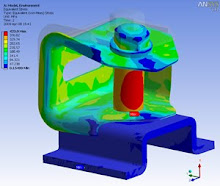Monday, January 4, 2010
Training
We offer the training for the Finite Element Analysis for beginner, intemediate and and advance level.
BE THERE....
Sunday, November 30, 2008
What is Stress Corrosion Cracking??
Corrosive environment act at existing crack crevices. Tensile stresses pull the metal apart at the crevices & exposes new metal to corrosive environment…….. This way attacked crack surfaces will propagate & will result in brittle failure of the metal.
Residual Stresses ------------> Due to cold working of Metal
Applied stresses -------------> Applied Internal Pressure
Corrosive Environment -----> Chloride, H2S in water
Thursday, November 27, 2008
The Allowable Stresses Limits as per ASME VIII Div.2
And the limits can be taken from ASME VIII div 2 as follow:
Primary Membrane and Bending (combined) Stress Intensity = 1.5 fallow
Local Membrane and Bending (combined) Stress Intensity = 3 fallow
Stress intensity is defined as twice the maximum shear stress (which is equivalent to the difference between the largest principal stress and the smallest principal stress as a given point).
Primary membrane stress refers to a membrane stress occurring across thickness of any section or is average stress across full width.
Primary Membrane and Bending (combined) Stress Intensity refers to primary membrane stress plus bending stress excluding secondary and peak stresses.
Local Membrane and Bending (combined) Stress Intensity refers to primary membrane stress plus bending stress including secondary stress but not peak stresses.
Secondary Stress refers to normal stress or shear stress developed by the constraint adjacent parts or by self-constraint of a structure.
Peak Stress refers to stress which does not cause any noticeable distortion and is objectionable only as a possible source of fatigue crack or brittle fracture.
Tuesday, November 25, 2008
The Resonance
Resonant phenomena occur with all types of vibrations or waves: there is mechanical resonance, acoustic resonance, electromagnetic resonance, and resonance of quantum wave functions. Resonant systems can be used to generate vibrations of a specific frequency, or pick out specific frequencies from a complex vibration containing many frequencies.
In this chapter will be shown the resonance of the motor mount structure. The motor type is VSD motor, and will be operated at 60%,70%,80%,90%and 100% maximum at 345rpm.
The result shown that the resonance occur at 50% and 90% of the motor operation. This resonance is occur between motor and structure it self. So the final conclusion is operatio on those phase (50% and %90) is not recomended to avoid resonance between motor and structure.

Thursday, November 20, 2008
Flow Around A Baseball USING FLOTRAN
Introduction: In this example you will model air flow over a baseball.
Physical Problem: Compute and plot the velocity distribution over the baseball shown below.
· A Baseball is 7.48 cm in diameter. (radius of 3.74cm)
· The flow velocity (of air) over the baseball is approximately 40 m/s.
· Objective:
To plot the velocity profile around the ball.
To graph the velocity distribution above and below the ball.
· You are required to hand in print outs for the above.
· Figure:

IMPORTANT: Convert all dimensions and forces into SI units.
· Create the larger area, then the area defining the baseball.
· Subtract the baseball area from the larger area.
· Define the Element Properties as a 2D Air Element
· Define the Material Properties of the Air Element (Density and Viscosity are the important qualities)
| Mesh the plate with a mesh size of 0.005 on the edges of the baseball, and 0.2 on the edges of the outer area. | |
| Apply Boundary Conditions (No Slip along the edges of the baseball, velocity along the left line of the large area, and Atmospheric Pressure (P=0 in ANSYS) along the top, right and bottom lines of the large area. | |
| Iterate 20 times and solve. (Ideally the iteration count would be at least several thousand times to make sure that the solution converges… but computational time dictates that in order to be able to solve the problem in a reasonable amount of time, the iteration number should be trimmed down to 20) | |
| Plot the Velocity distribution in the X and Y directions, this is the answer you should obtain with 20 iterations:
|
(Contour Plot)
(Vector Plot)
Monday, November 17, 2008
How to provide vibratiob calculation on FEA
You use modal analysis to determine the natural frequencies and mode shapes of a structure. The natural frequencies and mode shapes are important parameters in the design of a structure for dynamic loading conditions. They are also required if you want to do a spectrum analysis or a mode superposition harmonic or transient analysis.
You can do modal analysis on a prestressed structure, such as a spinning turbine blade. Another useful feature is modal cyclic symmetry, which allows you to review the mode shapes of a cyclically symmetric structure by modeling just a sector of it.
Modal analysis in the ANSYS family of products is a linear analysis. Any nonlinearities, such as plasticity and contact (gap) elements, are ignored even if they are defined. You can choose from several mode-extraction methods: Block Lanczos (default), subspace, PowerDynamics, reduced, unsymmetric, damped, and QR damped. The damped and QR damped methods allow you to include damping in the structure. The QR Damped method also allows for unsymmetrical damping and stiffness matrices. Details about mode-extraction methods are covered later in this section



